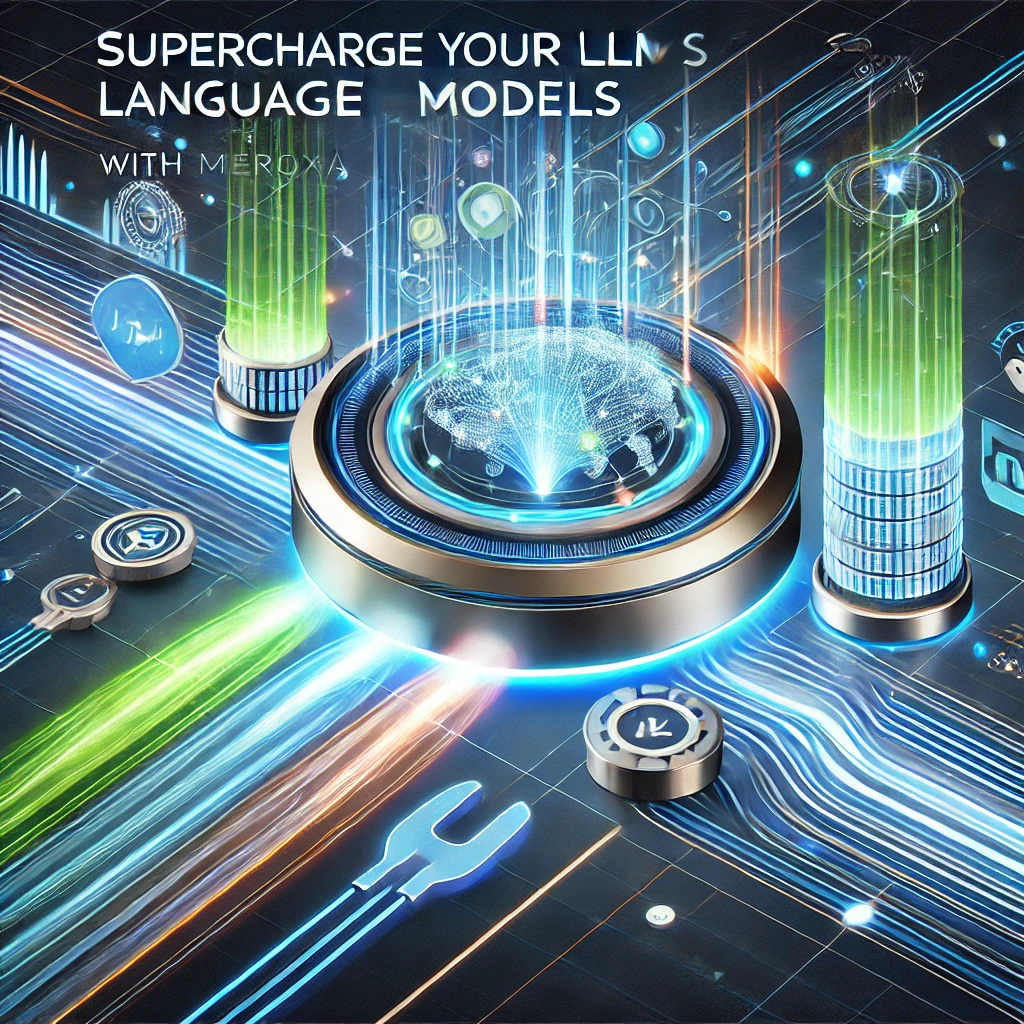
The recent DeepSeek announcement has demonstrated a powerful hybrid training approach that combines supervised learning (SL) and reinforcement learning (RL) to achieve ChatGPT-like performance with significantly fewer computational resources. At the heart of its success is an efficient multi-stage training pipeline that transitions from SL to RL while leveraging high-quality feedback loops.
At Meroxa, we believe that real-time data orchestration is critical to unlocking this level of efficiency for companies building their own LLMs. In this post, we’ll dive deeper into how DeepSeek works, how real-time data pipelines play a crucial role, and how Meroxa integrates into LLM training architectures to replicate and surpass these results.
How DeepSeek Works
DeepSeek achieves its performance through an efficient hybrid training process that combines Supervised Learning (SL) and Reinforcement Learning (RL). This multi-stage approach reduces the need for extensive datasets and computational resources while optimizing model performance.
Here’s how it works:
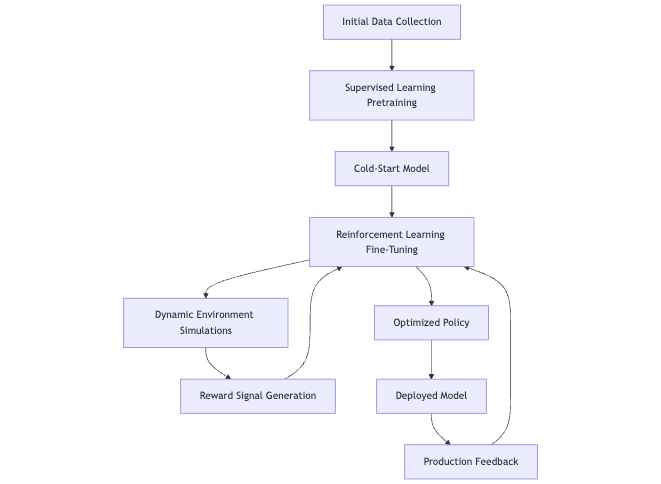
Detailed Stages of DeepSeek
- Initial Data Collection:
- Gather labeled data from domain experts or curated datasets. This data forms the foundation for supervised learning.
- Supervised Learning Pretraining:
- Train a base model using the collected labeled data. This step creates a "cold-start" model with basic capabilities, reducing the need for random exploration in RL.
- Reinforcement Learning Fine-Tuning:
- Transition the pretrained model into an RL framework. The model interacts with dynamic simulations or real-world environments, learning to improve based on reward signals.
- Dynamic Environment Simulations:
- Use simulations that replicate real-world conditions. These environments are continuously updated with new data to ensure training relevance.
- Reward Signal Generation:
- Evaluate the model’s actions and generate reward signals based on predefined success metrics (e.g., accuracy, efficiency, or user satisfaction).
- Optimized Policy:
- Iterate through multiple RL cycles, refining the model’s policy to maximize cumulative rewards.
- Deployed Model:
- Deploy the trained model into production, where it operates based on its learned policy.
- Production Feedback:
- Collect real-time feedback from the deployed model’s performance. This feedback loop ensures the model continues to adapt to new data or changing conditions.
How Meroxa Enables DeepSeek-Level Performance
DeepSeek’s hybrid training pipeline relies heavily on fresh, high-quality data and efficient feedback loops. Without a robust real-time data orchestration layer, replicating this efficiency is challenging. This is where Meroxa excels.
Key Benefits of Meroxa for DeepSeek-Like Architectures:
- Real-Time Data Ingestion:
- Stream operational metrics, user interactions, and environment simulations into training pipelines.
- Ensure that training data is always up-to-date, reducing redundancy and improving model generalization.
- Seamless Feedback Integration:
- Enable closed-loop learning by streaming production feedback (e.g., user ratings, success/failure metrics) directly into RL pipelines.
- Scalable Feature Engineering:
- Use Meroxa’s platform to preprocess and transform data in real time, ensuring that training pipelines receive high-quality, actionable features.
- Dynamic Environment Updates:
- Keep RL environments dynamic by feeding in live data streams, ensuring simulations stay representative of real-world conditions.
Updated Workflow
The following workflow shows how Meroxa integrates into the training pipeline to enable DeepSeek-like performance:
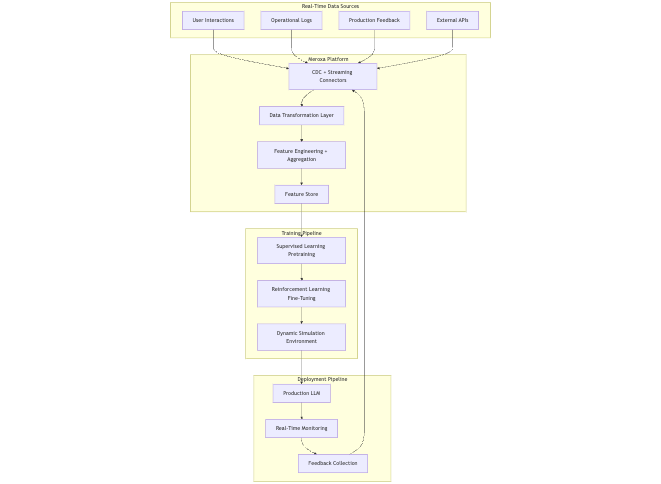
Detailed Integration: How Meroxa Fits into the Pipeline
1. Real-Time Data Sources
Meroxa connects to diverse real-time data sources, such as:
- User interactions: Chat logs, clicks, or other behavioral data.
- Operational logs: System metrics like latency, throughput, or errors.
- Production feedback: Model evaluation metrics, customer ratings, or outcomes.
- External APIs: Third-party data streams (e.g., stock prices, social media trends).
2. Meroxa’s Platform
Meroxa acts as the central data orchestration layer:
- Connectors: Seamlessly ingest data using CDC, streaming APIs, or message queues like Kafka.
- Transformation Layer: Clean, filter, and preprocess raw data streams.
- Feature Engineering: Aggregate and create features needed for training (e.g., state-action pairs for RL or reward signals).
3. Training Pipeline
- Supervised Learning (SL): Use Meroxa's preprocessed data to pretrain the LLM.
- Reinforcement Learning (RL): Stream live data into RL environments to fine-tune the model based on up-to-date conditions.
- Dynamic Simulations: Continuously update simulations with real-world data for more accurate environment modeling.
4. Deployment and Feedback
- Deploy the LLM in production and monitor its performance in real time.
- Stream feedback metrics back to Meroxa for ongoing training and optimization.
Real-Life Applications of DeepSeek-Like Architectures with Real-Time Data
Real-time data pipelines, enabled by platforms like Meroxa, empower businesses to train and deploy more efficient and performant large language models (LLMs) across various domains. Below, we explore detailed use cases for such architectures and highlight how real-time data integration transforms performance and adaptability.
1. Conversational AI for Customer Support
In customer support, chatbots powered by LLMs often face challenges in adapting to evolving customer queries, new product launches, or unexpected issues. Static training datasets quickly become outdated, leading to suboptimal responses and user dissatisfaction. Meroxa addresses this by streaming live chat logs, customer feedback, and conversation outcomes into the training pipeline. Supervised learning is employed initially to provide the chatbot with a strong linguistic foundation, while reinforcement learning refines its ability to resolve complex issues based on real-world feedback.
Meroxa integrates seamlessly by ingesting live interaction data through CDC connectors, transforming it into actionable features, and feeding these into the LLM’s supervised pretraining and reinforcement learning loops. The chatbot is continuously fine-tuned using data collected from production environments, creating a feedback loop that ensures it evolves alongside user expectations.
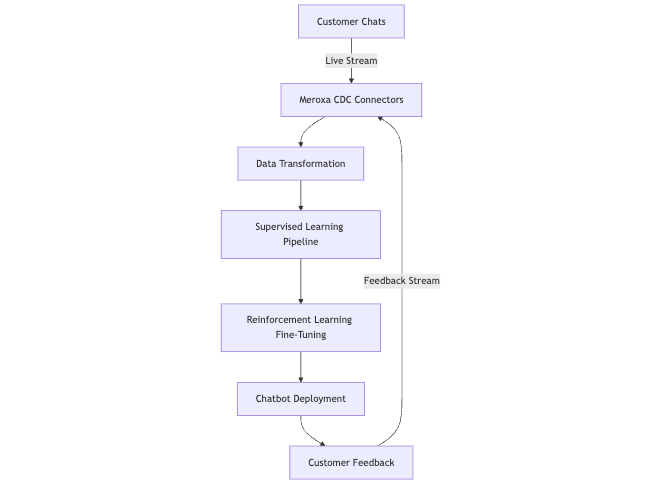
This continuous improvement cycle transforms the chatbot into a highly responsive and context-aware virtual assistant, reducing user frustration and improving resolution rates.
2. Personalized E-Commerce Recommendations
E-commerce platforms rely on recommendation engines to drive engagement and increase sales. However, static models often fail to account for real-time changes in customer behavior, such as trending products during promotions or seasonal preferences. Meroxa enables continuous real-time data integration by ingesting clickstream data, cart additions, and abandoned cart metrics.
Using Meroxa’s platform, raw customer data is transformed into actionable features and fed into reinforcement learning pipelines. The recommendation engine continuously refines its suggestions based on live user behavior and feedback loops. This enables the model to adapt dynamically, prioritizing products that align with real-time shopping trends.
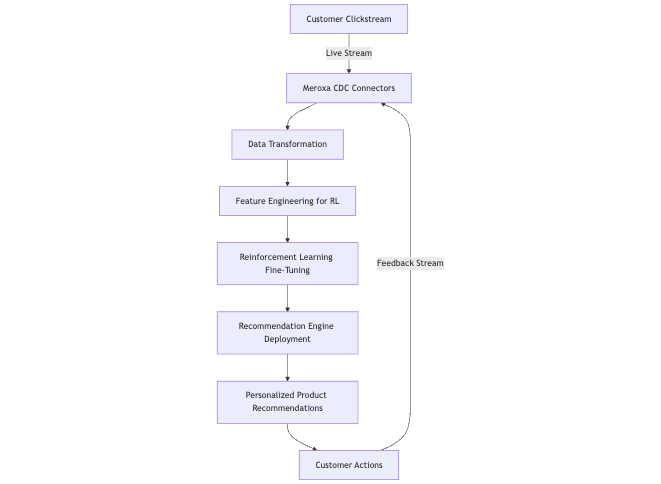
3. Fraud Detection for Financial Institutions
Detecting fraud in financial transactions requires models that can quickly adapt to emerging patterns and techniques used by malicious actors. Static fraud detection systems struggle to identify new anomalies because they rely on historical data that becomes outdated. Meroxa provides a solution by streaming live transactional data, anomaly reports, and confirmed fraud cases into the training pipeline.
The system uses supervised learning for pretraining, enabling the detection of common fraud patterns. Reinforcement learning further fine-tunes the model by exposing it to real-time transaction simulations, allowing it to learn from both successful detections and missed anomalies. Meroxa’s feedback loop ensures that confirmed fraud cases are reintegrated into the training process, creating a continuously evolving fraud detection system.
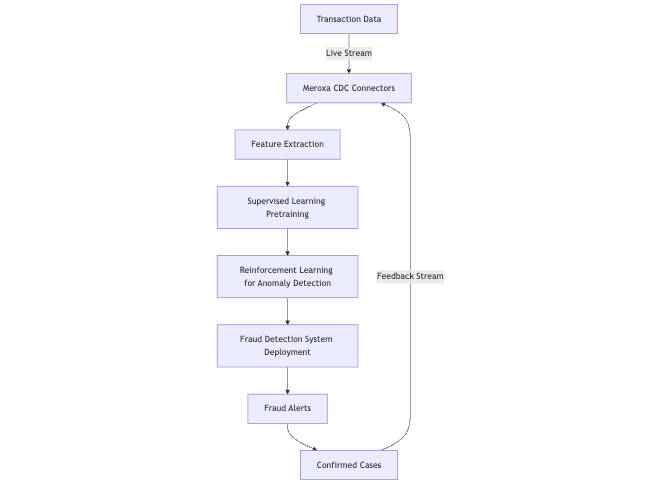
This architecture ensures financial institutions are equipped with proactive, adaptive fraud detection systems that minimize losses and maintain trust.
4. Adaptive Financial Modeling
In financial modeling, LLMs are frequently used to forecast market trends, predict stock movements, or assess credit risk. However, financial markets are inherently volatile, and models trained on static datasets fail to reflect real-time conditions, leading to inaccurate predictions. Meroxa enables adaptive modeling by streaming live market data, economic indicators, and transactional logs directly into the training pipelines.
The platform facilitates the preprocessing and transformation of raw financial data into relevant features. The LLM undergoes supervised pretraining to capture long-term patterns and trends. This is followed by reinforcement learning, where the model interacts with dynamic simulations or live environments to adapt to market fluctuations. Feedback from deployed predictions informs further fine-tuning, ensuring the model’s continuous improvement.
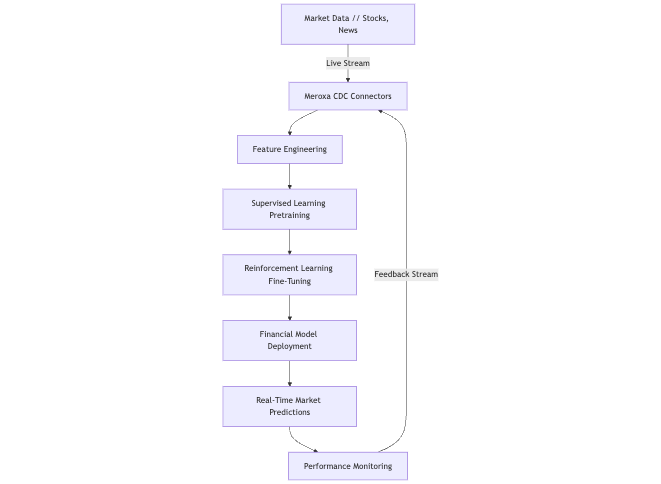
This integration allows financial institutions to deploy models that remain accurate and reliable, even in rapidly changing economic environments.
Conclusion
DeepSeek has shown us that high-performance models don’t require endless resources—they require efficient pipelines and fresh data. With Meroxa, your team can build real-time data workflows that rival or exceed the efficiency of DeepSeek’s approach, enabling your LLMs to deliver superior results at a fraction of the cost.
Ready to build smarter, faster pipelines? Contact us to learn more about how we can help you achieve DeepSeek-level performance. Follow us on Twitter, LinkedIn, and YouTube for more insights and updates!
